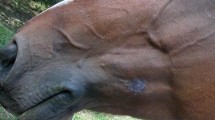Abstract
In order to appreciate the pathogenicity of several geophilic Chrysosporium species (including Anixiopsis stercoraria, Chrysosporium keratinophilum, C. tropicum, C. pannorum, C. state of Arthroderma curreyi, C. state of A. multifidum, and C. state of A. tuberculatum), the authors have realized two series of experimental infestations. Inoculation of these fungi on the back of guinea pigs produced rare erythematous scaling lesions which spontaneously disappeared 3–5 weeks later. No real hair invasion was observed. In white mice, eight weeks after intraperitoneal inoculation, granulomas with necrotic center were observed in the peritoneal tissue with C. keratinophilum, C. tropicum, C. state of A. curreyi and C. state of A. tuberculatum. Conidia were often intact in necrotic centers and retrocultures were positive. With C. state of A. curreyi, spherical spores associated with rare budding cells were noted. The pathogenic role of these keratinophilic fungi is uncertain. However, their ability to remain viable for several weeks in skin and peritoneal tissue indicates that they could become pathogen in certain circumstances.
Similar content being viewed by others
References
Albala F, Moreoa A, Lopez G. Isolement de Anixiopsis stercoraria sur des lésions dermiques humaines en Zaragoza (Espagne). Bul Soc Fr Mycol Med 1982; 2: 84–87.
Chabasse D. Taxonomic study of keratinophilic fungi isolated from soil and some mammals in France. Mycopathologia 1988; 101: 130–40.
Chabasse D, Bouchara J.-Ph, De Bièvre C. Flore fongique des bacs à sable, mise en évidence, signification. Mycopathologia 1985; 90: 3–13.
Chabasse D, Guiguen C, Couatarmanac'h A, Launay H, Reecht V, De Bièvre C. Contribution à la connaissance de la flore kératinophile isolée de petits mammifères sauvages et du lapin de garenne en France. Discussion sur les espèces fongiques rencontrées. Ann Parasit Hum Comp 1987; 4: 357–68.
De Vroey Ch. Sur quelques ascomycètes isolés des lésions cutanées chez l'homme. Bul Soc Fr Mycol Med 1976; 5: 161–3.
Gueho E, Villard J, Guinet R. A new human case of Anixiopsis stercoraria mycoses: Discussion of its taxonomy and pathogenicity. Mykosen 1985; 28: 430–6.
Hubalek Z. Mouse inoculation with various saprophytic fungi. Mykosen 1977; 20: 229–34.
Hubalek Z, Hornich M. Experimental infection of white mouse with Chrysosporium and Paecylomyces. Mycopathologia 1977; 3: 173–8.
Krempl-Lamprecht L. Uber das Vorkommen von Pilzen aus der Gattung Chrysosporium auf der Haut. In: Grimmer H, Rieth H, eds. Krankheuiten durch Schimmelpize bei Mensch und Tier. Berlin-Heidelberg-New York: Springer Verlag, 1965: 136–41.
Marin G, Campos R. Dermatofitosis por Aphanoascus fulvescens. Sabouraudia 1984; 22: 311–4.
Omsberg P. Gymnoascaceae and Onygenaceae as contaminants of skin, hair and nails. Mykosen 1979; 22: 325–7.
Otcenasek M, Dvorak J. The isolation of Chrysosporium keratinophilum (Frey) Carmichael 1962 and similar fungi from Czechoslovakian soil. Mycopathologia 1964; 23: 121–4.
Quadripur SA. Unter Suchungen über die Pathogenität von Chrysosporium. Mykosen 1979; 22: 441–7.
Rippon JW, Lee FC, Mc Millen S. Dermatophyte infection caused by Aphanoascus fulvescens. Arch Derm 1970; 102: 552–5.
Todaro F, Griseo G, Urzi C. A propos d'un cas de tinea pedis par Anixiopsis fulvescens var. fulvescens (Cooke) De Vries. Bul Soc Fr Mycol Med 1984; 13: 239–42.
Toshniwal R, Goodman S, Syed AA, Ray V, Bodino C, Kallick CA. Endocarditis due to Chrysosporium species: A disease of medical progress? J Infect Dis 1986; 153: 638–9.
Vanbreuseghem R, De Vroey Ch. Dermatophyte infection by Anixiopsis stercoraria in a wild boar (Sus scrofa). Mykosen 1980; 23: 16–20.
Woodgyer AJ. Asymptomatic carriage of dermatophytes by cats. N Z Vet J 1977; 25: 67–9.
Author information
Authors and Affiliations
Additional information
This paper was presented at the Xth congress of the International Society for Human and Animal Mycology at Barcelona, Spain from June 27 to July 1, 1988.
Rights and permissions
About this article
Cite this article
Chabasse, D., De Gentile, L. & Bouchara, J.P. Pathogenicity of some chrysosporium species isolated in France. Mycopathologia 106, 171–177 (1989). https://doi.org/10.1007/BF00443059
Accepted:
Issue Date:
DOI: https://doi.org/10.1007/BF00443059




